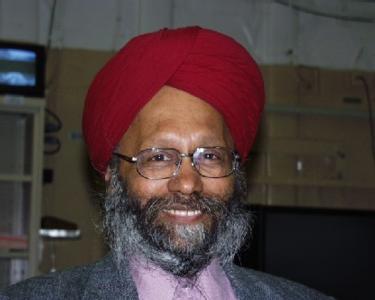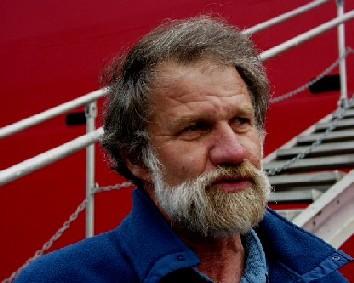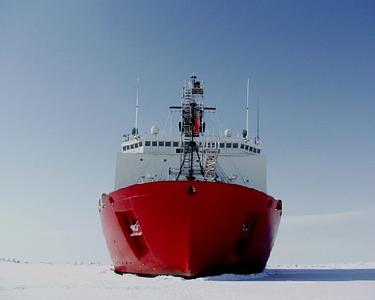18 May, 2000
Ice Trial Reports
DRAFT
May 18, 2000
Daily Data (20:30):
Lat. 5054.024334N
Long. 05120.277699W
Heading 190.633 deg
Air Temp. 4.05C 39.29 F
True Wind Dir. 191 deg
True Wind Speed 30 knots
USCGC Healy Facts: Mission Description
to function as a world-class high latitude research platform
to be employed in icebreaking operations during all seasons in the Arctic
and Antarctic (designed for extended winter operations including intentional
wintering over)
Dear Everyone,
Phase 3, Leg 2 of the USCGC Healy's Ice Trials is quickly coming to a close.
It now appears that we will arrive at our port of call, St. John's,
Newfoundland, Canada, earlier than first anticipated. We are due to arrive
sometime tomorrow afternoon or evening.
At our Healy-wide science meeting tonight, project reports were presented.
Terry Tucker, Co-Chief scientist of this phase of the ship's ice trial
studies, U.S. Army Cold Regions Research and Engineering Laboratory (CRREL),
Hanover, NH, gave me permission to share the following excerpt from his
report with you.
The ice trial of the USCGC Healy provides an excellent example of
cooperation between the Canadian Ice Service, the US National Ice Center,
the US Coast Guard, and the international group of scientists measuring the
ship performance. With exception of the multi-year floe and first year
ridge, most tests required finding suitably large areas of level first year
ice.
From RadarSat imagery received and processed on the Canadian Ice Service
(CIS) IceVu system, the Healy ice team identified potential testing sites
based on floe size and roughness estimated from the radar backscatter
brightness. Members of the ice team then reconnoitered the floes with the
helicopter, measured their thicknesses, and designated them as suitable or
not. The ice team then used RadarSat and Defense Meteorological Satellite
Program-Optical Line Scanner (DMSP-OLS) imagery along with helicopter
reconnaissance information to assist in routing the ship to the site.
Once on site, the ship normally penetrated into the floe a single ship
length. At this point, a core was taken and its temperature measured to
document the properties of the floe, and to confirm the thickness as
measured from the helicopter. The ship then proceeded to run a variety of
tests in the floe with the length of the run dictated by the amount of level
ice available. The ship usually stopped at the end of the run at which time
the ice team was placed on the ice to profile thickness and snow depth
beside the broken ice track.
Thicknesses were measured at 5m intervals with the EM-31 electromagnetic
induction instrument towed across the ice surface in a kayak and by drilling
holes every 50 to 100m. On board the ship, the ice core was processed by
cutting it into 10 cm. long sections whose diameter and length were measured
and weighed. Thick sections were sliced off the samples for documentation
of the crystal structure. Samples were then melted and salinity was
measured. Brine volume and flexural strength were calculated from standard
equations. The EM-31 measurements were converted to ice thicknesses using
the drill hole measurements for calibration. A helicopter reconnaissance
mission was often launched after the on-ice measurements to located the next
test area. Terry Tucker
Devinder S. Sodhi, U.S. Army Cold Regions Research and Engineering
Laboratory (CRREL), Hanover, NH, shares the following information from the
summary statements in his report this evening.
The icebreaking capability of USCGC Healy are better than her
design values of breaking 4.5-ft thick, level ice at 3 knots at full
power level of 30,000 HP. For ice thickness in the range of 135 and
140 cm (4.43 and 4.59 ft), she broke at speeds in the range of 4.66
and 5.68 knots at a power level below 30,000 HP. She also broke
360-cm thick (11.8 ft thick) multi-year ice as well as one first-year
ridge by backing and ramming. Devinder S. Sodhi.
For further information, please refer to my journal entries of May 6, 2000
"Profiling Ice Thickness"; May 7, 2000 "Determining Ice Strength"; May 9,
2000 "Multi-year Ice and Progress Summary"; and May 11, 2000 "Level Ice
Trials."
The scientists and crew appear to be very pleased with the success of the
Healy's ice trials and the data collected. The Healy not only exceeds
design specifications, but also has exceptional maneuverability and
performance characteristics.
Data on ice core 7A of April 14, 2000 follows.
Best regards,
Sandra Kolb
sandrakolb@hotmail.com
../tea_kolbfrontpage.html
../
../
Core 7A level ice 0414, End of Start-Up Test
14-April-00 Total length 68 cm
Latitude 63 deg 16.59 min
Longitude 62 deg 14.78 min
Comments: chips at 55 cm during processing core
Brine volume for -2>T>-22.9
Brine volume coefficients:
F1(T) COEF. -4.732 -22.450 -0.640 -0.011
F2(T) COEF. 8.90E-02 -0.018 -0.001 0.000
|
depth cm
|
temp C
|
salinity
|
weight g
|
|
5
|
-6.8
|
7.3
|
282.3
|
|
15
|
-6.2
|
6.3
|
342.1
|
|
25
|
-5.5
|
6
|
336.51
|
|
35
|
-4.6
|
5.4
|
322.44
|
|
45
|
-3.8
|
5.7
|
369.08
|
|
55
|
-3.2
|
5.4
|
80.2
|
|
65
|
-3
|
5
|
208.78
|
|
|
|
|
|
|
|
|
|
length mm
|
diameter mm
|
density
|
|
|
82.55
|
68.9
|
0.917
|
|
|
98.35
|
69.7
|
0.912
|
|
|
96.5
|
69.8
|
0.911
|
|
|
92.12
|
69.7
|
0.917
|
|
|
103.7
|
70
|
0.925
|
|
|
22.78
|
70.1
|
0.912
|
|
|
59.42
|
70.15
|
0.909
|
|
|
|
|
|
|
|
|
|
|
RHOI
|
brine vol
|
air vol
|
|
|
0.918
|
0.055
|
0.01111
|
|
|
0.9179
|
0.0511
|
0.01598
|
|
|
0.9178
|
0.054
|
0.01629
|
|
|
0.9176
|
0.0576
|
0.00951
|
|
|
0.9175
|
0.0733
|
0.00297
|
|
|
0.9174
|
0.0809
|
0.01706
|
|
|
0.9174
|
0.0795
|
0.02
|
|
|
|
|
|
|
|
|
|
|
porosity
|
strength mpa
|
strength psi
|
|
|
0.0661
|
0.443
|
64.3
|
|
|
0.0671
|
0.466
|
67.6
|
|
|
0.0703
|
0.449
|
65.1
|
|
|
0.0671
|
0.429
|
62.3
|
|
|
0.0763
|
0.358
|
52
|
|
|
0.0979
|
0.331
|
47.9 chips
|
|
|
0.0995
|
0.335
|
48.6
|
|
|
|
|
|
|
|
|
|
average brine vol 0.0645
average strength mpa 0.395
average strength psi 57.3
--
April M. Metz
VailFest.rice.edu
Web Master
ametz@esci.rice.edu
713-348-2356

Devinder S. Sodhi. photo by Sandra

Terry Tucker and me, Sandra Kolb, in the Healy's main science lab discussing the project report for this evening's science presentations. photo by Chris Meadus

Terry Tucker presenting his report at the Healy science meeting. photo by Sandra

Terry Tucker. photo by Sandra

USCGC Healy in an ice floe. photo by Sandra
Contact the TEA in the field at
.
If you cannot connect through your browser, copy the
TEA's e-mail address in the "To:" line of
your favorite e-mail package.
|
